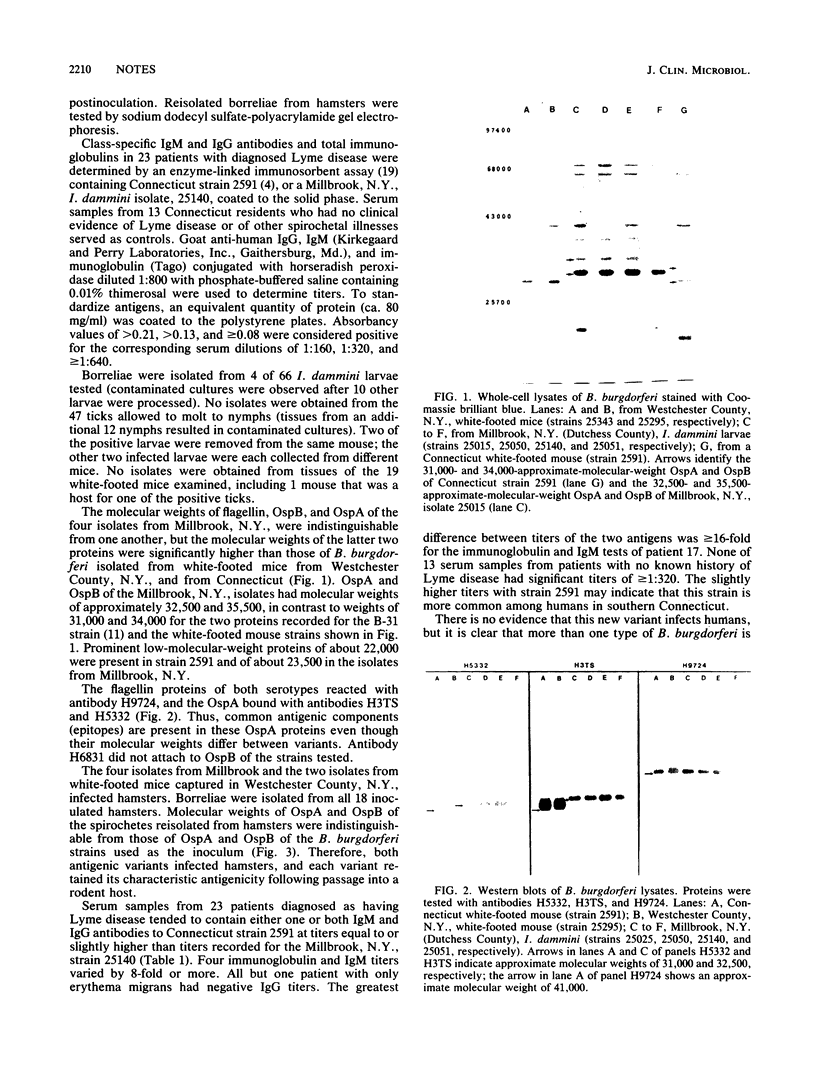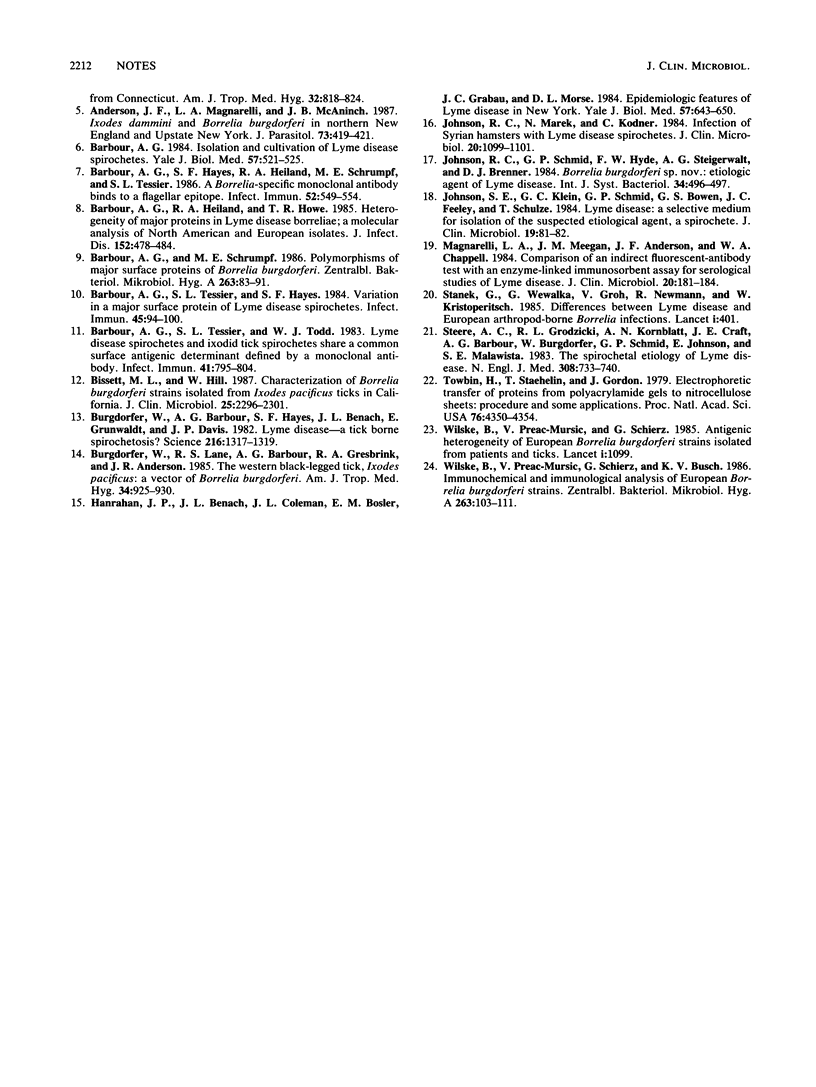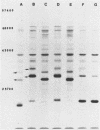Abstract
A previously undescribed Borrelia burgdorferi antigenic variant was isolated from each of four Ixodes dammini larvae removed from white-footed mice, Peromyscus leucopus, captured in Millbrook, N.Y. This site is in the northern range of the known distribution of the tick in the northeastern United States. The molecular weights of approximately 32,500 and 35,500 for outer surface A and outer surface B proteins, respectively, were distinctly higher than those for previously characterized isolates from North American ticks, humans, and wild mammals. A prominent low-molecular-weight protein of about 23,500 was also present. All four isolates infected Syrian hamsters and retained their antigenicity after passage through these rodent hosts. Serum samples from patients with Lyme disease tended to have immunoglobulin M, immunoglobulin G, and immunoglobulin antibodies to Connecticut B. burgdorferi 2591 at titers slightly higher than or equal to those recorded for an antigenically different strain of B. burgdorferi from Millbrook, N.Y.
Full text
PDF



Images in this article
Selected References
These references are in PubMed. This may not be the complete list of references from this article.
- Anderson J. F., Duray P. H., Magnarelli L. A. Prevalence of Borrelia burgdorferi in white-footed mice and Ixodes dammini at Fort McCoy, Wis. J Clin Microbiol. 1987 Aug;25(8):1495–1497. doi: 10.1128/jcm.25.8.1495-1497.1987. [DOI] [PMC free article] [PubMed] [Google Scholar]
- Anderson J. F., Johnson R. C., Magnarelli L. A., Hyde F. W. Identification of endemic foci of Lyme disease: isolation of Borrelia burgdorferi from feral rodents and ticks (Dermacentor variabilis). J Clin Microbiol. 1985 Jul;22(1):36–38. doi: 10.1128/jcm.22.1.36-38.1985. [DOI] [PMC free article] [PubMed] [Google Scholar]
- Anderson J. F., Johnson R. C., Magnarelli L. A., Hyde F. W. Involvement of birds in the epidemiology of the Lyme disease agent Borrelia burgdorferi. Infect Immun. 1986 Feb;51(2):394–396. doi: 10.1128/iai.51.2.394-396.1986. [DOI] [PMC free article] [PubMed] [Google Scholar]
- Anderson J. F., Magnarelli L. A., McAninch J. B. Ixodes dammini and Borrelia burgdorferi in northern New England and upstate New York. J Parasitol. 1987 Apr;73(2):419–421. [PubMed] [Google Scholar]
- Barbour A. G., Hayes S. F., Heiland R. A., Schrumpf M. E., Tessier S. L. A Borrelia-specific monoclonal antibody binds to a flagellar epitope. Infect Immun. 1986 May;52(2):549–554. doi: 10.1128/iai.52.2.549-554.1986. [DOI] [PMC free article] [PubMed] [Google Scholar]
- Barbour A. G., Heiland R. A., Howe T. R. Heterogeneity of major proteins in Lyme disease borreliae: a molecular analysis of North American and European isolates. J Infect Dis. 1985 Sep;152(3):478–484. doi: 10.1093/infdis/152.3.478. [DOI] [PubMed] [Google Scholar]
- Barbour A. G. Isolation and cultivation of Lyme disease spirochetes. Yale J Biol Med. 1984 Jul-Aug;57(4):521–525. [PMC free article] [PubMed] [Google Scholar]
- Barbour A. G., Schrumpf M. E. Polymorphisms of major surface proteins of Borrelia burgdorferi. Zentralbl Bakteriol Mikrobiol Hyg A. 1986 Dec;263(1-2):83–91. doi: 10.1016/s0176-6724(86)80107-9. [DOI] [PubMed] [Google Scholar]
- Barbour A. G., Tessier S. L., Hayes S. F. Variation in a major surface protein of Lyme disease spirochetes. Infect Immun. 1984 Jul;45(1):94–100. doi: 10.1128/iai.45.1.94-100.1984. [DOI] [PMC free article] [PubMed] [Google Scholar]
- Barbour A. G., Tessier S. L., Todd W. J. Lyme disease spirochetes and ixodid tick spirochetes share a common surface antigenic determinant defined by a monoclonal antibody. Infect Immun. 1983 Aug;41(2):795–804. doi: 10.1128/iai.41.2.795-804.1983. [DOI] [PMC free article] [PubMed] [Google Scholar]
- Bissett M. L., Hill W. Characterization of Borrelia burgdorferi strains isolated from Ixodes pacificus ticks in California. J Clin Microbiol. 1987 Dec;25(12):2296–2301. doi: 10.1128/jcm.25.12.2296-2301.1987. [DOI] [PMC free article] [PubMed] [Google Scholar]
- Burgdorfer W., Barbour A. G., Hayes S. F., Benach J. L., Grunwaldt E., Davis J. P. Lyme disease-a tick-borne spirochetosis? Science. 1982 Jun 18;216(4552):1317–1319. doi: 10.1126/science.7043737. [DOI] [PubMed] [Google Scholar]
- Burgdorfer W., Lane R. S., Barbour A. G., Gresbrink R. A., Anderson J. R. The western black-legged tick, Ixodes pacificus: a vector of Borrelia burgdorferi. Am J Trop Med Hyg. 1985 Sep;34(5):925–930. doi: 10.4269/ajtmh.1985.34.925. [DOI] [PubMed] [Google Scholar]
- Hanrahan J. P., Benach J. L., Coleman J. L., Bosler E. M., Grabau J. C., Morse D. L. Epidemiologic features of Lyme disease in New York. Yale J Biol Med. 1984 Jul-Aug;57(4):643–650. [PMC free article] [PubMed] [Google Scholar]
- Hovind-Hougen K., Asbrink E., Stiernstedt G., Steere A. C., Hovmark A. Ultrastructural differences among spirochetes isolated from patients with Lyme disease and related disorders, and from Ixodes ricinus. Zentralbl Bakteriol Mikrobiol Hyg A. 1986 Dec;263(1-2):103–111. doi: 10.1016/s0176-6724(86)80109-2. [DOI] [PubMed] [Google Scholar]
- Johnson R. C., Marek N., Kodner C. Infection of Syrian hamsters with Lyme disease spirochetes. J Clin Microbiol. 1984 Dec;20(6):1099–1101. doi: 10.1128/jcm.20.6.1099-1101.1984. [DOI] [PMC free article] [PubMed] [Google Scholar]
- Johnson S. E., Klein G. C., Schmid G. P., Bowen G. S., Feeley J. C., Schulze T. Lyme disease: a selective medium for isolation of the suspected etiological agent, a spirochete. J Clin Microbiol. 1984 Jan;19(1):81–82. doi: 10.1128/jcm.19.1.81-82.1984. [DOI] [PMC free article] [PubMed] [Google Scholar]
- Magnarelli L. A., Meegan J. M., Anderson J. F., Chappell W. A. Comparison of an indirect fluorescent-antibody test with an enzyme-linked immunosorbent assay for serological studies of Lyme disease. J Clin Microbiol. 1984 Aug;20(2):181–184. doi: 10.1128/jcm.20.2.181-184.1984. [DOI] [PMC free article] [PubMed] [Google Scholar]
- Stanek G., Wewalka G., Groh V., Neumann R., Kristoferitsch W. Differences between Lyme disease and European arthropod-borne Borrelia infections. Lancet. 1985 Feb 16;1(8425):401–401. doi: 10.1016/s0140-6736(85)91424-2. [DOI] [PubMed] [Google Scholar]
- Steere A. C., Grodzicki R. L., Kornblatt A. N., Craft J. E., Barbour A. G., Burgdorfer W., Schmid G. P., Johnson E., Malawista S. E. The spirochetal etiology of Lyme disease. N Engl J Med. 1983 Mar 31;308(13):733–740. doi: 10.1056/NEJM198303313081301. [DOI] [PubMed] [Google Scholar]
- Towbin H., Staehelin T., Gordon J. Electrophoretic transfer of proteins from polyacrylamide gels to nitrocellulose sheets: procedure and some applications. Proc Natl Acad Sci U S A. 1979 Sep;76(9):4350–4354. doi: 10.1073/pnas.76.9.4350. [DOI] [PMC free article] [PubMed] [Google Scholar]
- Wilske B., Preac-Mursic V., Schierz G. Antigenic heterogeneity of European Borrelia burgdorferi strains isolated from patients and ticks. Lancet. 1985 May 11;1(8437):1099–1099. doi: 10.1016/s0140-6736(85)92396-7. [DOI] [PubMed] [Google Scholar]





